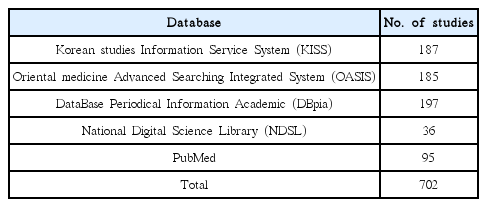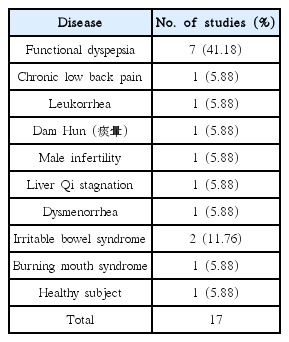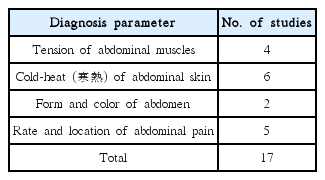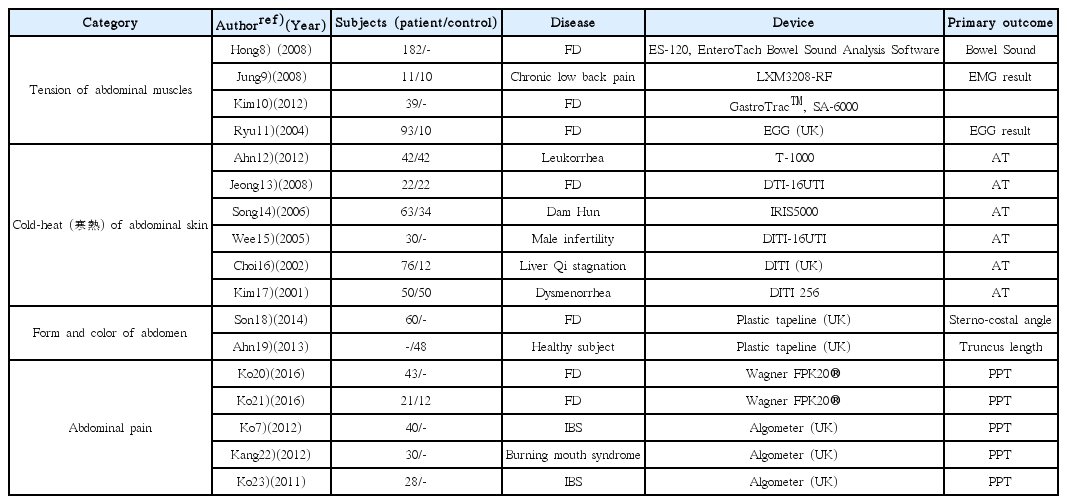References
1. Kim JH, Park SJ, Son HC, Lee KN. Historical study of abdominal examination. The Korean academy of medical gigong 2002;6(1):111–127.
2. Lee JH, Kim JK, Yoon CY. The Study on the Historical Expansion Process And the Method of the Abdominal Diagnostics. The Journal Of The Korea Institute Of Oriental Medical Diagnostics 2000;4(1):69–82.
3. Seo SH, Yim HJ, Jung IC, Lee SR. The clinical study on 1 case of Patient with Tremor by Bok-Jin. Daejeon university journal of the institute of oriental medicine 2007;16(1):69–79.
4. Lee BK, Park YB, Kim TH. Korean Medicine Diagnostics Seoul: Seongbosa; 2009. p. 280–281.
5. Lee HJ. A development of the quantitative indicator of abdominal examination for clinical application: pilot study[master degree dissertation] Seoul: Kyung Hee Univ; 2013.
6. World Health Organization. WHO International Standard Terminologies on Traditional Medicine in the Western Pacific Region World Health Organization; 2007. 356
7. Ko SJ, Kim JS, Ryu BH, Han GJ, Kim SK, Park JW. Clinical Study on association between abdominal symptoms and pressure pain threshold in the treatment for irritable bowel syndrome with diarrhea -In the view of quantification of the oriental abdominal diagnostics. Korean Journal Orient Int Med 2012;fall(0):93–102.
8. Hong IA, Yoon SH. A Study of Gastrointestinal Parasympathetic Nerve Activity and Pyloric Valve Function, and Clinical Characteristerics in Patients with Functional Dyspepsia - Analysis of Bowel Sound. Korean Journal Orient Int Med 2008;29(3):666–674.
9. Jung JY, Lee JH, Nam KB, Kin SS. Meridian Electromyograph Analysis on Features of Abdominal Muscles in Chronic Low Back Pain Patients. J Oriental Rehab Med 2008;18(4):203–215.
10. Kim SY, Han CW, Park SH, Kwon JN, Lee I, Hong JW, et al. Correlation Study between Electrogastrography and Heart Rate Variability in Dyspeptic Patients. Korean J Oriental Physiology & Pathology 2012;26(4):532–539.
11. Ryu JM, Yoon SH, Lim JH, Han SY, Jang SY, Kim HK, et al. The Usefulness of Electrogastrography on the Differential Diagnosis of Deficiency or Excess Condition in Patients with Functional Dyspepsia. Korean Journal Orient Int Med 2004;25(4):346–355.
12. Ahn JY, Choi SK, Hwang DS, Lee JM, Jang JB, Lee KS, et al. A Retrospective Cross-sectional Study on Leukorrhea in Relation with Lower Abdomen Temperature and Physical Symptoms. J Korean Obstet Gynecol 2013;26(3):93–102.
13. Jeong SH, Im IH, Um EJ, Lee BJ, Na BJ. Investigation on evaluation of functional dyspepsia by using Digital Infrared Thermal Images. J of Oriental Medical Thermology 2008;6(1):56–62.
14. Song KK, Park MY, Choi HY, Kim JD. Clinical Evaluation and The Diagnositic Significances of Disital Infrared Thermal Image(D.I.T.I.) on the Patients of Dam Hun(痰暈). Korean J Oriental Physiology & Pathology 2006;20(2):488–493.
15. Wee HS, Lee CH, Cho JH, Jang JB, Lee KS. A Study on Abdominal Temperature of Male Infertility Patients. J of Oriental Medical Thermology 2005;4(1):23–28.
16. Choi JE, Kim RS, Cho JH, Jang JB, Lee KS. DITI of the Abdomen on Liver Qi Stagnation Patients. J of Oriental Medical Thermology 2002;1(1):20–27.
17. Kim HW, Kim YS, Lee KS. DITI of the Abdomen on twenties’ Dysmenorrhea Patients. J of Oriental Medical Thermology 2001;14(1):311–318.
18. Son JY, Kim JS. Diagnostic Values of Tongue Coating Thickness and Sterno-costal Angle in Functional Dyspepsia. Korean Journal Orient Int Med 2014;35(2):157–174.
19. Ahn JS, Park SK, Yu JS. Relationship between Sasang Constitution and Length of Chest and Abdominal Region. Korean Journal of Acupuncture 2013;30(2):131–134.
20. Ko SJ, Kim H, Kim SK, Park K, Lee J, Lee BJ, et al. Reliability and Validity of Modified Algometer in Abdominal Examination. Evid Based Complement Alternat Med 2016;2016:3052954. 10.1155/2016/3052954.
21. Ko SJ, Lee H, Kim SK, Kim M, Kim J, Lee BJ, et al. Development of the quantitative indicator of abdominal examination for clinical application: a pilot study. J Altern Complement Med 2015;21(6):358–363.
10.1089/acm.2014.0185.
22. Kang K, Kim JS, Seon JK, Son JH, Kim JY, Jang SW, et al. Correlation between Qi-Stagnation and Pressure Pain Threshold on CV17 (Danzhong : 膻中) in Burning Mouth Syndrome Patients - In the Perspective of Quantification of Pressure Pain Threshold on CV17 by using Algometer. Korean Journal Orient Int Med 2012;33(4):498–510.
23. Ko SJ, Kim JS, Ryu BH, Park JW. Clinical Study on application of algometer to irritable bowel syndrome -In the view of quantification of the oriental abdominal diagnostics. Korean Journal Orient Int Med 2011;10(fall):173–181.
24. Joh KH, Toshiaki K, Katsutoshi T, Moon SK, Ko CN, Kim YS, et al. An Introduction Of Abdominal Palpation Signs In Japanese Oriental Medicine. Korean Journal Orient Int Med 1997;18(1):86–96.




